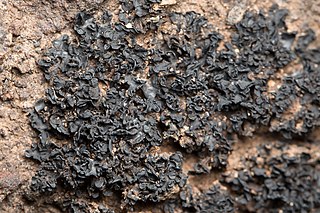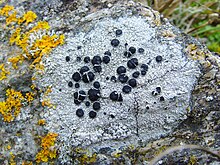
The Arthoniales is the second largest order of mainly crustose lichens, but fruticose lichens are present as well. The order contains around 1500 species, while the largest order with lichenized fungi, the Lecanorales, contains more than 14000 species.

The Lecanoraceae are a family of lichenized fungi in the order Lecanorales. Species of this family have a widespread distribution.

Gloeoheppiaceae is a family of ascomycete fungi in the order Lichinales. The family contains ten species distributed amongst three genera. Most species are lichenised with cyanobacteria. Species in this family are mostly found in desert areas. Modern molecular phylogenetics analysis casts doubt on the phylogenetic validity of the family, suggesting a more appropriate placement of its species in the family Lichinaceae.

The Lichinaceae are a family of ascomycete fungi. Most species are lichenized with cyanobacteria, and have a distribution largely in temperate regions.

The Baeomycetales are an order of mostly lichen-forming fungi in the subclass Ostropomycetidae, in the class Lecanoromycetes. It contains 8 families, 33 genera and about 170 species. As a result of molecular phylogenetics research published in the late 2010s, several orders were folded into the Baeomycetales, resulting in a substantial increase in the number of taxa.

The Stictidaceae are a family of fungi in the order Ostropales. It has 30 genera and about 240 species.

The Icmadophilaceae are a family of lichen-forming fungi in the order Pertusariales. The family was circumscribed in 1993 by the mycologist Dagmar Treibel. It contains 9 genera and 35 species.
Aphanopsidaceae is a family of lichen-forming fungi in the order Lecanorales. It contains the genera Aphanopsis and Steinia, comprising five species. The family was circumscribed in 1995 by the lichenologists Christian Printzen and Gerhard Rambold.

Calvitimela is a lichen genus in the family Tephromelataceae. Members of the family Tephromelataceae are crustose lichens with green photobionts and lecideine or lecanorine apothecia. The species in Calvitimela have lecideine apothecia, are saxicolous and are primarily found in alpine to arctic regions.

Candelariaceae is a family of lichen-forming fungi in the order Candelariales. It contains seven genera and about 73 species.

The Lecideaceae are a family of lichens in the order Lecideales. It contains about 30 genera about roughly 250 species. A major distinguishing characteristic of the family is the lecanoroid form of the fruiting bodies: typically circular, dark, and without a thalline margin. Most species in the family are lichenised with green algae, although a few species, scattered amongst several genera, are lichenicolous–they live on other lichens. Lecideaceae lichens tend to grow on rocks, wood, and soil. The largest genus in the family, Lecidea, was once a loosely circumscribed wastebasket taxon containing hundreds of morphologically similar species with generally crustose thalli, photobiont-free apothecial margins and translucent, single-celled ascospores. The overall taxonomy and classification within the family has been made more accurate with recent molecular phylogenetics studies.

The Caliciaceae are a family of mostly lichen-forming fungi belonging to the class Lecanoromycetes in the division Ascomycota. Although the family has had its classification changed several times throughout its taxonomic history, the use of modern molecular phylogenetic methods have helped to establish its current placement in the order Caliciales. Caliciaceae contains 39 genera and about 670 species. The largest genus is Buellia, with around 300 species; there are more than a dozen genera that contain only a single species.

Mycoblastus is a genus of crustose lichens in the family Tephromelataceae. Members of the genus are commonly called blood lichens.
Josef Hafellner is an Austrian mycologist and lichenologist. He was awarded the Acharius Medal in 2016 for his lifetime contributions to lichenology. Before his retirement, he was a professor at the Karl-Franzens-Universität in Graz. Hafellner started developing an interest in lichens while he was a student at this institution, studying under Josef Poelt. He earned a master's degree in 1975 and a PhD in 1978, defending a doctoral thesis about the genus Karschia. In 2003, Hafellner received his habilitation. By this time, he had studied with French lichenologist André Bellemère (1927–2014) at Saint-Cloud, where he learned techniques of transmission electron microscopy and how their application in studying asci could be used in lichen systematics. His 1984 work Studien in Richtung einer natürlicheren Gliederung der Sammelfamilien Lecanoraceae und Lecideaceae has been described as "probably the single most influential publication in lichen systematics in the latter half of the 20th century".

Trapeliaceae is a family of lichens in the order Baeomycetales. The family contains 12 genera and about 125 species.

Schaereria is a genus of lichen-forming fungi. It is the sole genus in the family Schaereriaceae, which itself is the only family in the Schaereriales, an order in the subclass Ostropomycetidae of the class Lecanoromycetes. Most Schaereria species are crustose lichens that live on rocks. Schaereria was first proposed by Gustav Wilhelm Körber in 1855 and was later taken up by other lichenologists despite periods of disuse.

Rhizocarpales are an order of lichen-forming fungi in the subclass Lecanoromycetidae of the class Lecanoromycetes. It has two families, Rhizocarpaceae and Sporastatiaceae, which contain mostly crustose lichens.

Massalongiaceae is a small family of lichen-forming fungi in the order Peltigerales. It has three genera and seven species.
Harpidiaceae is a small family of lichen-forming fungi, containing two genera and five species. It is of uncertain classification in the Pezizomycotina.
Aspiciliopsis is a genus of lichen-forming fungi in the family Trapeliaceae. It has two species, both of which occur in the Southern Hemisphere.
















